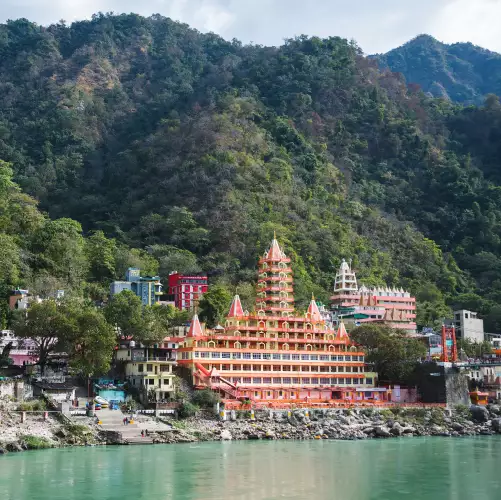-
Amber Fort (Amer Fort): A breathtaking and majestic fort-palace that is the crown jewel of Jaipur. Perched on a high hill, its formidable exterior belies a stunningly beautiful and artistic interior. The journey up to the fort on the back of an elephant is a classic tourist experience. Inside, you can explore a stunning complex of palaces, halls, and gardens. The most famous part is the Sheesh Mahal (Mirror Palace), a spectacular hall where the walls and ceiling are covered in a mosaic of tiny mirrors that glitter like a thousand stars with a single flame.
-
Hawa Mahal (Palace of Winds): The iconic, honeycombed facade of the Hawa Mahal is perhaps the most famous symbol of Jaipur. This extraordinary five-story structure, built of pink sandstone, is not a palace in the traditional sense, but an elaborate screen. It was built so that the royal women, who lived in strict purdah, could observe the processions and daily life on the street below without being seen themselves. Its 953 small windows (jharokhas) allowed a cool breeze to flow through, making it a perfect “palace of winds.”
-
City Palace: Located in the heart of the old city, this magnificent complex is still the home of the Jaipur royal family. It is a stunning blend of Rajput and Mughal architecture, with a series of beautiful courtyards, gardens, and palaces. You can visit the Mubarak Mahal, now a textile museum, and the Chandra Mahal, which houses art and artifacts. The four stunningly decorated gates in the inner courtyard, representing the four seasons, are a major highlight.
-
Jantar Mantar: A UNESCO World Heritage Site and a testament to the scientific genius of its founder, Maharaja Sawai Jai Singh II. This incredible observatory is a collection of nineteen massive architectural astronomical instruments. Here you can see the world’s largest stone sundial, the Samrat Yantra, which is accurate to within two seconds, and other complex instruments used to track celestial bodies and predict eclipses.
-
Nahargarh Fort: Perched on the edge of the Aravalli hills, Nahargarh Fort offers the most spectacular panoramic view of the entire city of Jaipur. It was built as a place of retreat for the royal family. The fort is a fantastic spot to watch the sunset and to see the city lights begin to twinkle below, making it a favourite among photographers and romantics.
-
Jaigarh Fort: Connected to Amber Fort by a series of fortified passages, Jaigarh was the military stronghold, built to protect the main palace complex. It is a rugged and impressive fort that houses the Jaivana Cannon, which was once the world’s largest cannon on wheels. The fort has a largely intact structure and offers a fantastic insight into the military life of the Rajputs.
-
Johari Bazaar and Bapu Bazaar: A trip to Jaipur is incomplete without a shopping excursion. Johari Bazaar is the city’s famous gemstone and jewelry market, while Bapu Bazaar is renowned for its textiles, leather goods (especially the mojari footwear), and other local handicrafts. The vibrant atmosphere and colourful array of goods make for a fantastic experience.
-
Albert Hall Museum: The state museum of Rajasthan, this beautiful building is a stunning example of Indo-Saracenic architecture. It houses a rich and diverse collection of artifacts, including paintings, carpets, ivory, stone and metal sculptures, and even an Egyptian mummy.


















